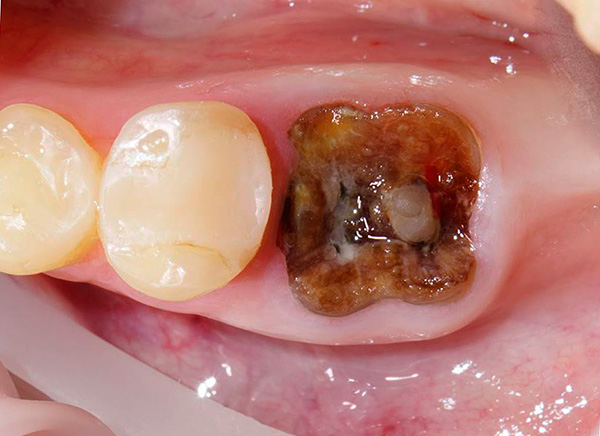
Next you will find out:
- In what cases it may be necessary to remove the root of the tooth, or part of it (for example, resection of the apex);
- Why the "rotten" tooth roots should be removed as soon as possible and that you can wait if you do not do it in time;
- In some cases, the roots of the tooth can still be saved (for subsequent prosthetics) and by what methods such preservation is realized;
- Typical clinical situations where the root of a tooth is to be removed (and it is useful to know if, for example, a significant piece broke off a tooth during a meal);
- Methods for removing the roots of teeth, starting simple, and ending with complex and traumatic (using a dental chisel and a hammer);
- What to do if after the removal of the tooth in the hole there is a root or small fragments ...
Sometimes the crown part of a tooth is so badly damaged that only the root of the tooth eaten by caries remains - in such cases it usually becomes a question of removing these “rotten” residues.Often there are annoying injuries: for example, while eating, a piece of tooth can break away, and the chip (or crack) sometimes goes deep under the gum - in this case, it may also be necessary to remove the tooth root.
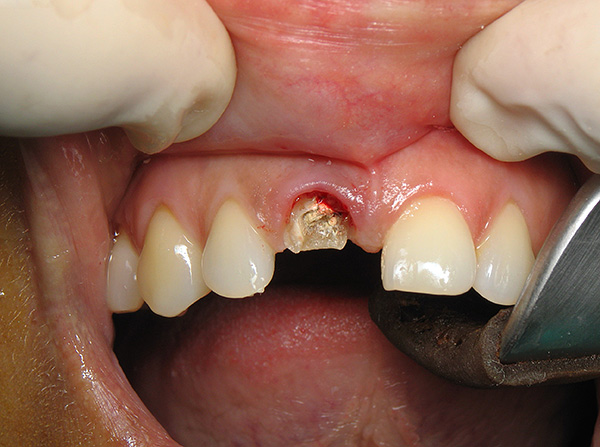
A separate story, when the tooth looks more or less functional, but the condition of its root (or roots) is far from the norm - there are cysts, granulomas. Then the dental surgeon may suggest resection of the root apex or even amputation of the entire tooth root. We will also talk about this a little lower ...
Fortunately, in some cases it is not necessary to remove the root of the tooth, and it can be limited to its treatment with subsequent prosthetics or restoration of the crown part of the tooth. However, it should be understood that the teeth residues (“rotten” roots) that are badly destroyed by the carious process should be parted as quickly as possible and without regrets, since their preservation brings more harm than good to health.
Let's start with this one. Let's see why, in fact, you need to remove the damaged tooth roots as soon as possible ...
Why you should remove the rotten destroyed remnants of the tooth roots
From the point of view of a dentist, the situation when a patient walks with decayed rotten teeth for years looks like this: this person does not feel sorry for himself. The fact is that in such cases, the roots of the teeth must be removed urgently (see the example in the photo below).
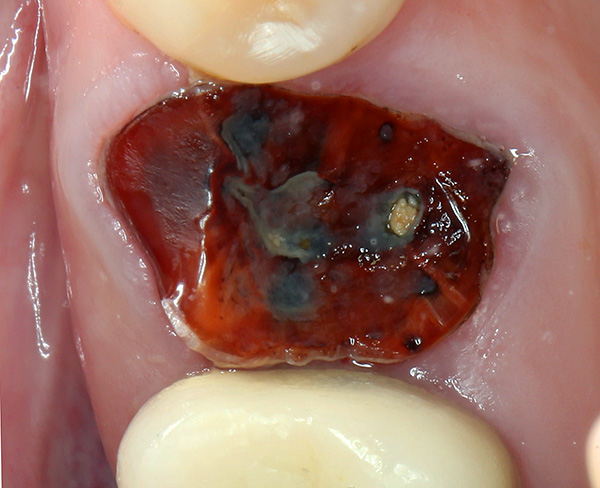
The reason is simple: rotten roots are a breeding ground for infection, and the more of them in the mouth, the more severe the problems are, and they are far from being limited to a persistent unpleasant smell from the mouth. These porous “willows” like a vacuum cleaner absorb bacteria and food particles onto themselves. In addition to decaying food, hard-to-remove plaque is also present on tooth residues and almost always above and subgingival dental calculus, which also causes gums to suffer.
Almost in 100% of such cases, an inflammatory process is observed on the tips of rotten roots, accompanied by a depression of bone tissue, a granuloma or cyst is formed. Simply put, a purulent bag hangs at the top of the root, which is just waiting in the wings to break through with the formation of a “flux”.
The photo below shows an example of extracted teeth with cysts on the roots:
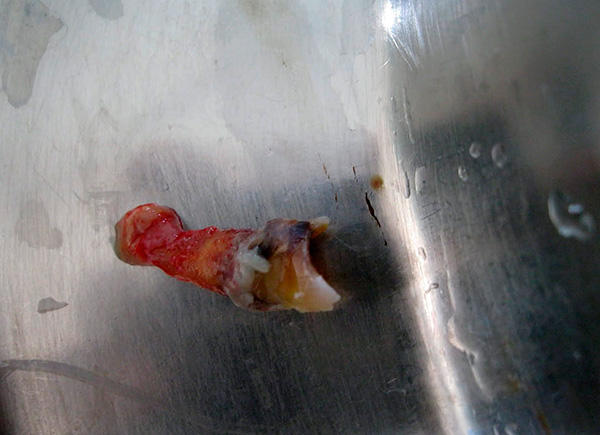
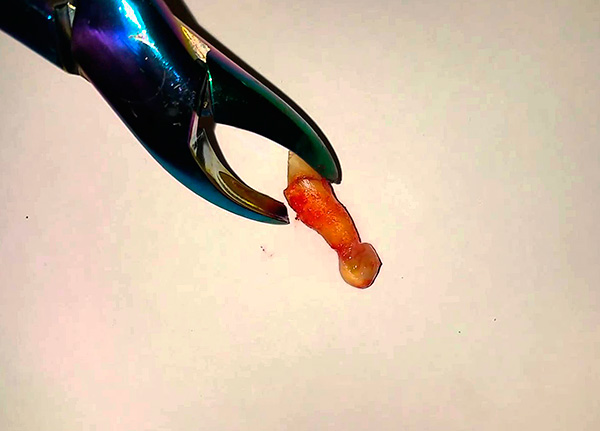
Against the background of the vital activity of microorganisms, a person’s immunity has to constantly spendtheir resources to fight infection, to somehow compensate for this problem (frequent diseases can be observed).
If such a tooth root is not removed, sooner or later the moment comes when the body’s forces can no longer prevent the spread of infection - an acute inflammatory process will occur, often accompanied by significant edema. The favorite phrase of such patients: “The root rotted for so many years, it did not hurt, but suddenly the cheek suddenly swelled, and as always, no time.”
On a note
And how, it is asked, to such a patient with a “flux”, to whom the slightest touch to the gum causes severe pain, should a dentist painlessly perform a tooth root removal? After all, almost always anesthesia is done in the projection of the roots of the tooth on the gum, and there at this moment a significant amount of pus accumulates. The surgeon has a choice: somehow try to make anesthetic injection as painlessly as possible, cut the gum, release pus, and send the patient home, and after a few days, when it feels better, calmly remove the destroyed tooth root.
Or you can delete here and now, but in this case, the risk of removing the root will be painful.
As you can see, it is not necessary to delay with the removal of rotten roots of the tooth - it is necessary to remove them, and the sooner the better.
In what cases can the tooth root be preserved, and by what methods is it implemented?
Suppose you have such a tooth (or even several) in the oral cavity, which is difficult to call a full-fledged tooth due to destruction, but it also falls under the category, popularly called “root”, with difficulty.
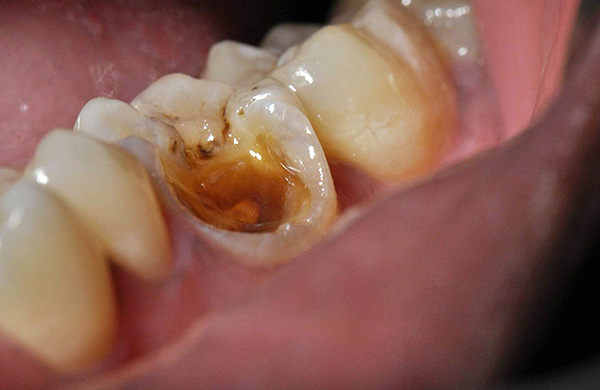
For example, for a long time there were large fillings on dead teeth, which for some reason fell out, and only “horns and legs” remained from the tooth: one or two walls or residues of the tooth walls. Or, for example, a significant piece broke off from the molar during the meal, and only a “stump” with sharp edges remained.
Is it necessary to remove the roots of the tooth in such cases, or is it still possible to come up with something to save them with subsequent prosthetics of the crown part?
So, today there are many so-called tooth-preserving methods - the main ones are divided into conservative and conservative-surgical.
Conservative methods of preserving teeth do not provide for surgical interventions,and the preservation of the root (tooth stump) is carried out by preparing the canals (if necessary) and restoring the coronal part with a suitable method, for example, by means of restoration with a light-cured material using a pin, or with an insert and crown.
A conservative surgical method may be required when there is an inflammatory process at the top of the tooth root: after filling the tooth canals (most often with dental cement), resection of the root apex is delayed or delayed. This operation, as a rule, is performed under local anesthesia, and can be performed for both single-root and multi-rooted teeth. The operation is generally simple and usually takes 15-30 minutes.
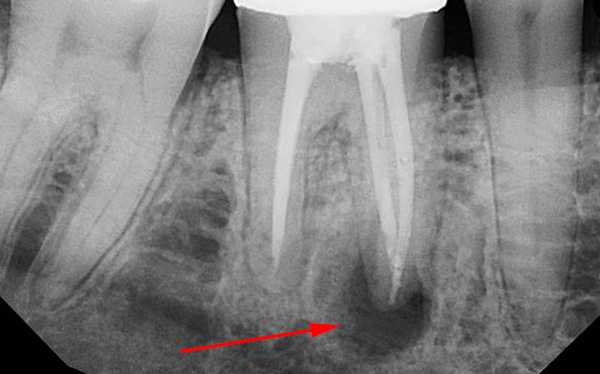
However, sometimes with the inflammatory process at the apex of the root or even the roots, it is possible to do without surgical procedures - if there is an opportunity to be treated with an anti-inflammatory agent injected into the canal (s), the dentist puts the drugs for a certain period (from 2-3 months to 1-2 years) with the expectation of bone recovery around the root apex. With a significant loss of bone tissue, the doctor is likely to choose the conservative surgical method, either as the only way to save a tooth,or in order to reduce the time of treatment (not a year, for example, but 1-2 months).
On a note
Resection of the apex of the tooth root is carried out in several stages. At the first stage, preliminary preparation takes place (anamnesis is collected, especially for allergies, the treatment of the surgical field) and anesthesia (most often with articain-type drugs).
The second stage involves the beginning of the operation itself: creating access to the apex of the root through a gum incision, exfoliation of soft tissues, cutting into the bones of a special small “window” and detecting the problem root.
At the third stage, a part of the root is cut off with a cyst or granuloma, after which preparations are inserted into the wound to stimulate the growth of bone tissue and accelerate healing. The wound is sutured. The prescription of drugs for home treatment (including painkillers) allows you to minimize possible painful sensations and allows the patient to return to normal life in a matter of days.
Hemisection and root amputation are much less popular methods to prevent the removal of the entire tooth.
During hemisection, the affected root is removed with a part of the rotten crown of the tooth, and healthy roots with the remaining whole crown part are left for prosthetics.
Amputation of the root of the tooth, in contrast to hemisection, does not imply the excision of the coronal part: only the root (whole) is removed with a cyst or granuloma present on it.
It is interesting
Exclusive options for the preservation of severely damaged tooth - this is coronoradicular separation and replantation of the tooth (for example, if the tooth was knocked out by mechanical action).
Coronoradicular separation is carried out in relation to large molars, when in the area of bifurcation or trifurcation of the roots (where the roots branch out) there is a non-treatable center of inflammation. The tooth is cut into two parts, and the affected tissue between the roots is removed. Subsequently, each tooth segment is covered with welded crowns with the restoration of the lost function of the dentition.
Tooth replantation - in other words, it is the return to the hole of the tooth, which for one reason or another was previously removed from it (on purpose, or, for example, was accidentally knocked out on impact). Sounds unbelievable, but true. To date, such operations are rarely performed, usually in cases where a tooth is brought to the dentist as if it has just been knocked out.
In Soviet times, when modern methods of preserving complex, destroyed roots were not available,similar methods were more or less popular for various unsuccessful conservative treatment options. For example, a dentist-surgeon could preliminarily remove a tooth, while a dentist-therapist performed intracanal treatment with filling and (sometimes) resection of the root apex (amputation, hemisection). The prepared tooth (or its part) was fixed back into the hole to its former place using splinting with exclusion from the bite for several weeks.
Due to the technical complexity and not always justification, today the technique of dental replantation is used only in exceptional situations.
In some cases, the root will still have to remove
If none of the tooth-preserving techniques can be applied, the roots of the tooth should be removed.
Below are the most common situations in the practice of the dentist, involving the removal of the tooth roots:
- For complex tooth fractures (for example, for longitudinal - see the example in the photo below);
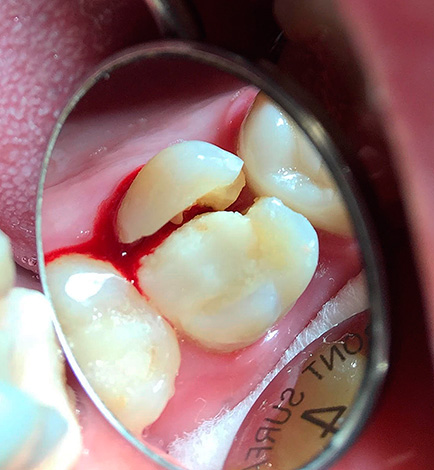
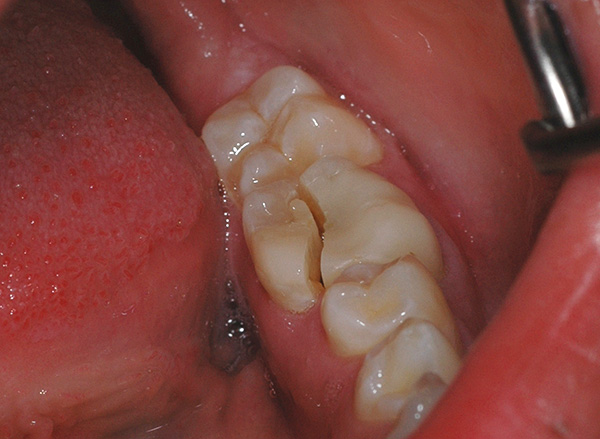
- Against the background of serious inflammatory processes near the root (large cyst, periostitis, osteomyelitis, abscess, phlegmon);
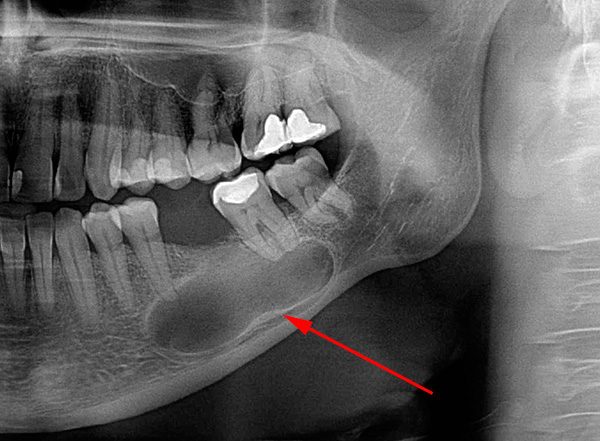
- The destruction of the crown of the tooth is significantly below the level of the gums;
- Mobility of the root of the III degree;
- Atypical position of the destroyed tooth (various dental anomalies).
And some others.
However, as noted above, far from every fracture of the tooth the remaining roots have to be removed. The splinter can break away from both the living tooth and the dead, that is, previously depulped, and the dead are more vulnerable in this respect, as they become fragile over time. So, if the root is not badly damaged and has a solid foundation, then the tooth is restored by conventional methods: canal treatment is performed (if the tooth was alive) and the coronal part is restored using restoration or prosthetics.
With regard to the roots of wisdom teeth, there are nuances: many patients rush to get rid of such teeth as soon as possible - the reasons may be different:
- Sometimes the hygiene of wisdom teeth is difficult and they are rapidly destroyed due to caries;
- Wisdom teeth that have erupted can cause displacement of the remaining teeth in the dentition, which often leads to the wrong bite;
- Sometimes eights lead to regular biting of the cheeks, that is, to chronic injury of the mucous membrane, and this is a dangerous risk of the appearance of malignant tumors.
And so on.However, before you rush to remove eights, it is worth taking into account the fact that there are cases when even a seemingly badly destroyed wisdom tooth is important for removable or non-removable prosthetics. Not all people can afford the installation of dental implants to “scatter” even with such teeth.
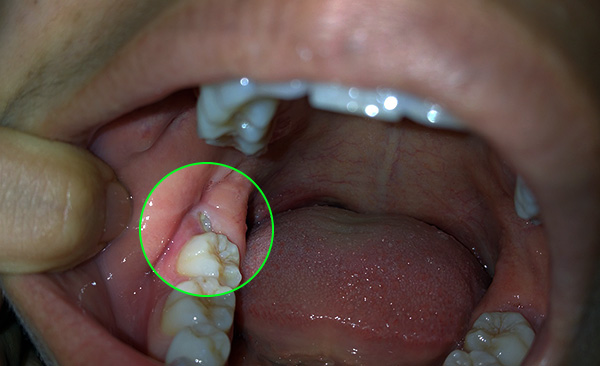
Therefore, in certain situations, a dentist can save the roots of a wisdom tooth, having performed their complete endodontic treatment and restoration of a tooth (for example, a tab) and then using it as one of the supports, for example, a bridge.
From the practice of the dentist
In fact, most dentists rather conditionally adhere to the list of indications for the extraction of a tooth or its roots. The fact is that over the years, a practitioner has formed his own opinion about the possibility of preserving a tooth in a given clinical situation (this is often the result of numerous trials and errors).
So, for example, an inexperienced orthopedic dentist may insist on preparing the roots of a particular tooth for a future bridge prosthesis, which the competent therapist, with great experience, supposes, refuses.justifying this by mobility of the root (or roots), destruction of the inter-root septum, obstruction of the canals due to the resorcin-formalin treatment method carried out many years ago, or a significant inflammatory focus on the top of the root. Even one of these reasons is quite enough to abandon such a venture.
In addition, there is such a thing as a “functional value of a tooth”: even if the root of a tooth can be technically restored in an accessible way, this does not mean that without a detailed analysis of the entire clinical situation, you should immediately begin to take it. Will the tooth be able to function normally in the future? If not, then there is little point in this preservation. For example, this applies to the roots of teeth that are outside the dentition, or wisdom teeth that do not have antagonists (that is, are not able as a result to perform a chewing function).
Ways to remove the roots of teeth: from simple to complex
In some patients of the old Soviet school, a doctor's message about the need to remove the root of the tooth causes almost panic. Usually such a reaction is associated with a number of the following fears:
- Is it really necessary to cut the root out of the gum, because it is simply impossible to grasp it with forceps (sometimes the remnants of the tooth really protrude slightly above the gum);

- Whether the dentist would chisel the remains of the tooth in order to extract the root through the fragments (in Soviet times, the separation of the tooth roots using a chisel and a hammer was common);
- Will the dentist cut the bone to gain access to the roots of the tooth ...
Feedback
“I have a molar tooth sprawled from the bottom left, they said that it is necessary to tear out the roots. Believe me, it is terribly painful, I myself went through it recently. And they also told me that I would hardly feel anything, it was comforting me so that I would not be very afraid. It's terrible, I burst into tears right in the chair, they even gave me a sedative. Kromsaly and hollowed my jaw for an hour, the doctor already sweated all over. The pain is wild, despite three injections ... "
Oksana, St. Petersburg
Fear of the dental office often leads to the fact that a person can walk for years with rotten teeth in his mouth: looking in a mirror - the root has not completely crumbled and does not hurt, which means you can still suffer. All this time, the remnants of the tooth will be subject to more carious destruction, which in the future may further complicate the process of root removal.
Meanwhile, if you do not pull up to the last, then it will be quite easy for the dentist-surgeon to remove the roots of the tooth with forceps, with specially adapted cheeks. Even if the roots are partially gummed, cuts are not made. Moreover, the lost roots of the roots have an access line, that is, the gums cannot even completely close the “rotten” over the years, so the dentist-surgeon can only slightly open them with a trowel and remove them with forceps. It usually takes about 3-10 minutes.
The photos below show the extraction of a tooth, the coronal part of which is destroyed almost to the level of the gum:

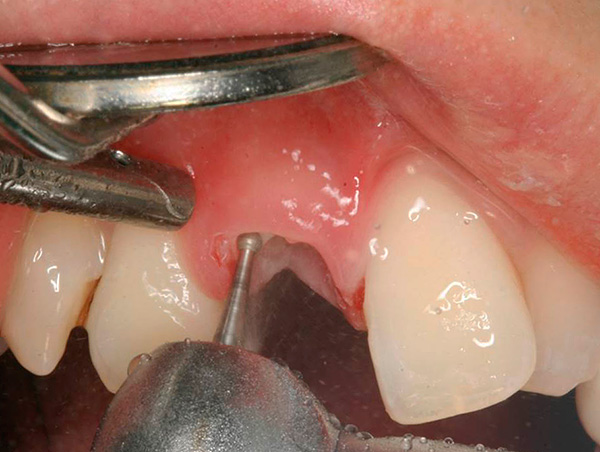
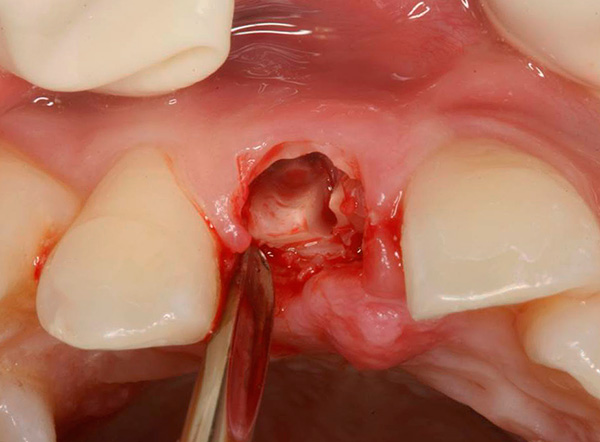
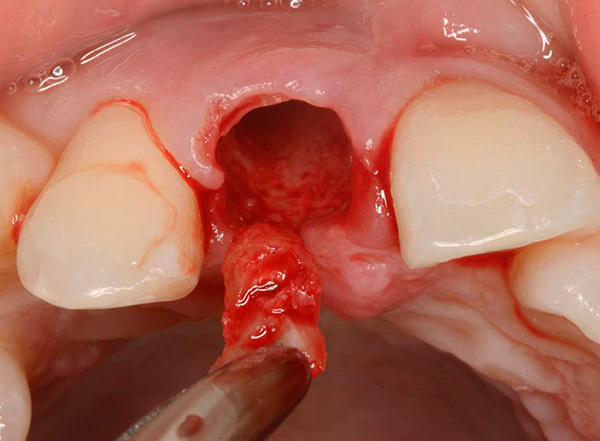
From the practice of the dentist
In patients in adulthood (40 years and above), in the overwhelming majority of cases, removing rotten tooth roots does not present any particular difficulties, since amid atrophy of the alveoli, reducing the height of partitions and the inflammatory process near the roots, the body “rejects” the roots, therefore, there is often a degree of mobility. Practicing doctors are well aware that the older the patient, the better, since removal along with anesthesia takes almost always a few minutes - to the delight of the patient and the doctor.
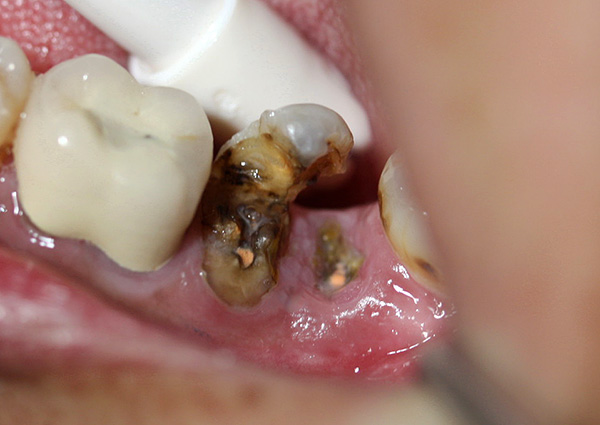
Now a few words about the chiseling of the tooth roots with the use of a chisel and a hammer. There are difficult cases when there is a tandem of 2-3 or more roots, that is, there is a full-fledged partition between them, and the patient’s age is relatively young, the bone tissue around the roots is full. In other words, a gift for the dentist-surgeon is clearly not expected.
In such cases, the forceps rarely help in solving the problem, and a professional dentist takes on ... No, not a bit and a hammer. Currently, a professional dentist prefers modern approaches to the removal of such roots: cutting out using a drill and removing the roots individually with an elevator and (or) forceps. This is especially true of the sixth teeth and wisdom teeth.
Photo of the tooth, the roots of which are separated by a drill before removal:
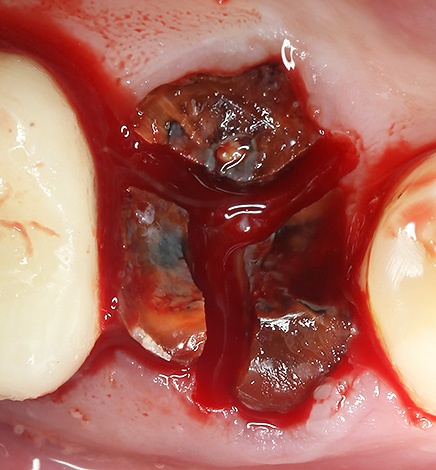
Then in what cases do they resort to a hammer and a chisel?
Extremely rarely, in dense villages of central Russia (figuratively speaking) this technique is used - moreover, it is used as the main,since the dentist-surgeon either does not know about the removal of the roots with the help of a drill and even drills his teeth with almost a whole crown, or he does not have a drill available (from the poor equipment of the cabinets everything happens).
As for the cases when cutting the roots of the drill does not help, this is a separate category: it is extremely rare, mainly on the lower wisdom teeth and the so-called “formalin” teeth (that is, those whose channels were previously treated with the resorcin-formalin method). In order not to let the patient go with the roots left in the hole, the doctor with the help of assistants resorts to this method. But the percentage of such situations is about 1-2% of the entire numerous flow of patients of a good dentist-surgeon.
With regard to pain during the procedure: during the removal of the roots of the tooth is exactly the same anesthesia in quality and technique as in the extraction of teeth with a crown part. If the dentist uses an out-of-date anesthetic and, moreover, does not have professional anesthesia techniques, the result will be deplorable, especially for the patient.
On a note
A topic that is rather actively exaggerated by the people - is it possible to remove a broken tooth by means of pliers? Even frightening (from a professional point of view) examples of removal by this tool are given. First, in many cases, a diseased tooth, which even has deep caries destruction, should not be removed, but can be successfully cured by a dentist-therapist. Secondly, anesthesia is required for removal, and without it the pain will be very severe. Thirdly, with such a tooth extraction at home, there is a high risk of infection in the wound with the subsequent development of complications. And this is not to mention the fact that many of the brave souls can use pliers to simply crush or break off part of the tooth, leaving the roots and fragments in the hole.
About situations when after the removal of a tooth, its remains remain in the hole
Patients' fears often concern not only the fear of removing the roots of the teeth, but also the prospect of a possible remaining tooth residues in the hole due to the doctor’s carelessness (for example, a broken root with a cyst or fragments). Indeed, in practice, not very experienced specialists sometimes encounter similar precedents. Interestingly, a number of such dentists are firmly convinced that everything will be in order, and they say to their patients: “Do not worry, in time the root will come out on its own.”
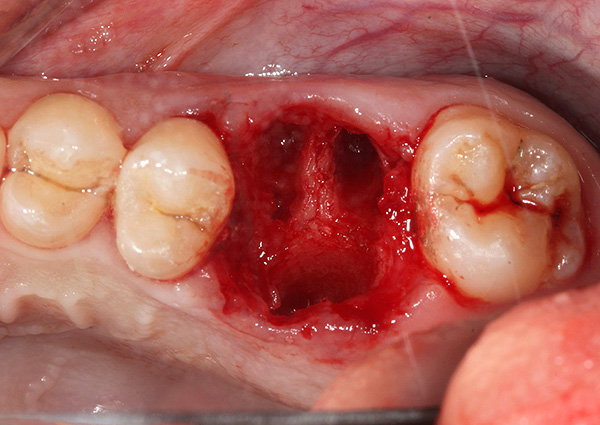
What happens if a root is not completely removed by a doctor?
With complicated removal of the tooth root, the dentist often gets into a situation when the root tip (tip) breaks off, and a review for further action closes the increased bleeding from the hole (in other words, the hole is covered with blood and it is problematic to see something in it). The professional can either work blindly, relying on his experience, or postpone the appointment, correctly explaining to the person what to do and when to visit him again to complete the work.
But if the doctor does not have much experience in removing teeth, or fundamentally prefers the tactic of “non-intervention” (sometimes so as not to lose his time), then he advises the patient to simply wait for the root to “come out on its own”. Say, do not worry, the problem will resolve itself.
Opinion dentist
The practice of leaving a broken tooth root in the hope that everything will be all right is flawed. Indeed, in many cases, a left root or fragment may not disturb for a long time,and over the years, the wound simply does not become fully tightened - something like a canal or a fistulous passage remains, and the root gradually moves to the surface of the gum. It can take a very long time (up to several years), and there is nothing good for the owner of such an incompletely extracted tooth: the infectious process at the apex of the root continues its negative impact on the body.
Worst of all it turns out when the top of a root with a granuloma or a cyst remains. Problems arise either immediately in the form of purulent inflammation on the gum ("flux"), or delayed, but they will almost certainly arise (they can happen even after 10 years). The most unpleasant situation is when the left root is tightened by the gum and a new bone is formed around it, that is, the remainder of the tooth lies in a kind of capsule separating it from healthy tissue. How much time will pass before it will all be felt is not important, but the later an appeal to the dentist is followed, the more likely it is that with the development of an exacerbation of the purulent process (periostitis, osteomyelitis, abscess, phlegmon) hospital on the operating table.
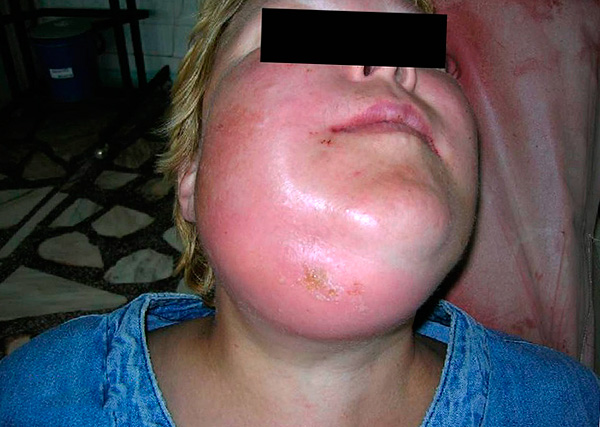
Thus, if the tooth was not completely removed (after removing the tooth, a fragment of the root remained in the hole), then it is advisable to take measures to bring the case begun by the doctor to the end, and this should be done soon. This will not leave the inflammatory focus for many years, despite the assurances of the attending physician to wait for everything to go away. In such cases, it is useful to turn to another dentist without leaving a slow-motion mine in his jaw.
After the extraction of the tooth, it may turn out that its roots will be extracted completely, but at the level of the gum you will already find some small fragments at home. Moreover, the dentist in the picture can state the absence of roots in the hole, but on the gingival margin will not pay enough attention. Here the fact is that a tooth destroyed by caries often crumbles during removal, and single fragments connected to the gum are not removed by the dental surgeon for several reasons:
- Poor visibility due to bleeding injured tissue;
- Inattention of the doctor;
- Negligence.
If this rubbish remains in the hole (even small pieces of carious tooth), then the risks of developing alveolitis, an infectious inflammation, increase to some extentaccompanied by pain, swelling, fever, general malaise and other unpleasant symptoms. That is why a competent dentist not only removes all the roots of a tooth, but also examines the wound for the presence of small fragments of the tooth, bone fragments (if the removal was difficult), a filling material.
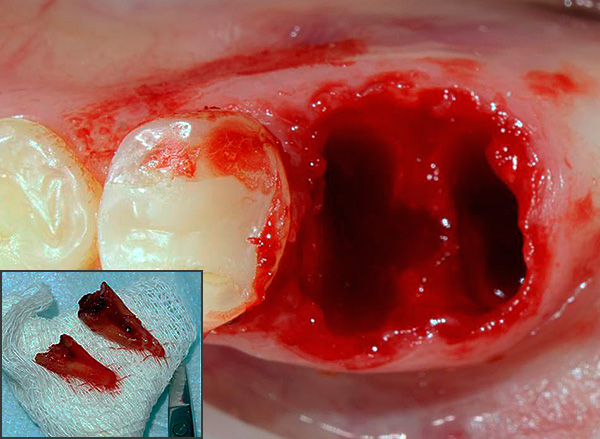
A clean wound heals, as a rule, significantly faster and more comfortable than a contaminated one, so it is important to consult a dentist in a timely manner and clean the hole if something foreign is noticed in it.
Is it possible to remove the tooth root by yourself
Today, on the Internet, you can often observe the appearance of video reviews about how people at home get their teeth removed. And there are not only video reviews, where adults and, to put it mildly, drunken men independently pull out their dilapidated teeth, but there are also examples of independent removal of milk teeth in children.
Let's see, is it worth it to experiment?
Not only does this look not very attractive from the aesthetic point of view (people writhe in pain, blood literally drains out), but the main concern is primarily the lack of sterile conditions during the procedure.You can not even talk about the professional component: if the removal of a more or less whole tooth is somehow realized from the tenth (provided that the crown part does not crumble into fragments), then the teeth that were completely destroyed by the root practically cannot be removed by themselves.
Therefore, to “pull out” your teeth at home (including staggering milk) should not even be attempted.
Interesting video: removal of the roots of two teeth, followed by wound closure
An accessible description of the tools used to remove teeth.

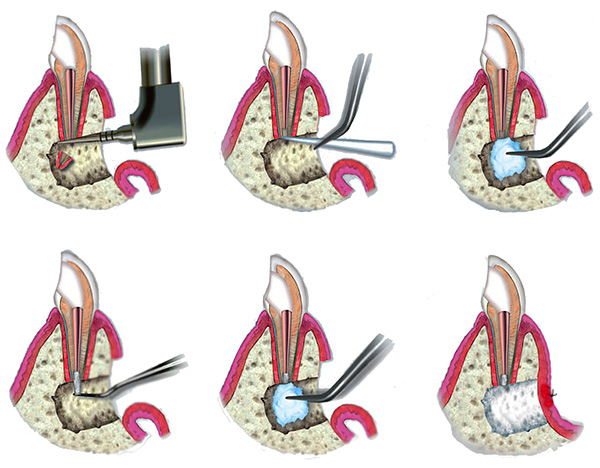
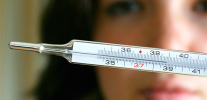
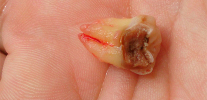
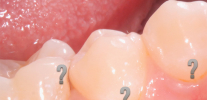
Removed in the clinic of Samara roots 5s. Everything was done professionally, the voids were cleaned, after the removal a picture was taken - to check the residues. If the doctor is friends with the brain, then in free dentistry he will do everything according to his mind. The main thing - do not be afraid! Treat your teeth on time.
Such articles can be read either by a dentist, or one who has never been to a dentist.
In my opinion, such knowledge should be given in schools, for example, in one of the lessons of biology, but it is necessary to tell about methods of treatment and prosthetics. It is very useful to look at your own problems with a dentist's look. And if I had learned about it at school age, then my attitude to my teeth and dentists would be completely different.
I read, I regret that I did not go to the dentist before. Mouthful of problems. Previously, he was afraid and it was a shame to show rotten. I have been going for a month, 5 implants and 12 crowns will be placed. Treat scary, but not painful. I would have known before, I would have gone a long time.
How much did the whole action cost? If not difficult, then about the points. I myself am from Rostov. What for what I want to estimate. The problem is the same.
Actually, to treat now is not painful and not scary, but EXPENSIVE. Very expensive. Just from a dentist: the treatment of pulpitis of a three-channel tooth with the subsequent restoration of the crown part of the light-cured filling due to the great destruction during the treatment process cost me 18,800 rubles.
It is very expensive! Moreover, no one can say for sure the exact cost of such treatment in advance. Is it only when removed.
And I was spoiled by the dentist’s attitude to the dentists in the regional center when I was forced to visit her in the 7th grade during the holidays. Removed the nerve and treated the tooth without any painkillers. Also hissed on me. After that, I have never been to a dentist.
It is strange that there is a problem with the remaining fragments. As far as I remember, even with the normal drilling of nerves from the roots, I was sent to an x-ray (with needles stuck in holes) ... And it happened that after this, scraping with a file needle continued further!
I, as a patient, there can only distinguish the fact that it is a tooth and holes are drilled to the roots, but the doctor clearly gives a full information about everything that is hidden in the depths.
Hello! Quite right, the doctor controls the main stages with the help of pictures to do a good job. But often, especially in budgetary institutions (on the stream), the pictures do not take - the doctor simply does not have time for reinsurance, and in the clinic itself there may be no serviceable equipment and consumables. All this increases the risk of problems. And without extracting fragments, various kinds of problems most often arise: from alveolitis to serious purulent manifestations in the maxillofacial region. At the same time, the gums heal hard, fragments in many patients do not come out themselves, and the risks of an unfavorable outcome are great.
Almost a week ago, they removed the bottom eight ruined by caries. I was preparing to survive the nightmare, but everything went very quickly and painlessly. The doctor made anesthesia and simply pushed the tooth (or rather, its remains) with an elevator. It took just a couple of seconds.Until now, I can not believe that I got rid of one fright. Thanks to the doctor! Anyone who faces this frightening procedure, I wish the same quick and successful deletions!
The upper left 7-ka cracked along due to mechanical stress and a piece of tooth fell off (the long part extends deep enough into the gum). A dentist at the request to remove this tooth said that it is not necessary to remove a tooth and it is necessary to restore it.
Restored. After a couple of weeks, the tooth cracked and fell apart, and the gum swelled a little. Then the temperature 38-39, aches, headache and stomatitis on the surface of the mouth (focus is the gum of the damaged tooth). What to do? Do you treat like that?
Hello! The tactics of the dentist was incorrect. It was necessary either:
1. Immediately remove a tooth according to indications;
2. Or, carry out the restoration of its coronal part with a tab + crown, possibly with preliminary intra-channel preparation.
I think that now the most likely scenario would be the removal of the roots of the tooth, the treatment of stomatitis and the inflammatory process in the gums. After removing the roots, you should plan a plan for restoring the defect: either withusing implantation, or using modern orthopedic structures (bridges, for example).
I am very afraid, fear keeps me going to the dentist. I have rotten roots - my whole mouth. I am 63 years old. How to overcome fear?
Good afternoon, Nina. In good clinics, the team includes not only dentists of different specializations, but also anesthesiologists, who will select the appropriate therapy to make the treatment for you as comfortable as possible. Be stronger than fears. And remember that good doctors wish you only good. With this attitude, go to the doctor, and very soon you will remember your fears with laughter, and not with trembling. A bonus you will be the absence of toothache, a beautiful smile and the ability to fully chew tasty and healthy food.
Nina, an idiot in dentistry for general anesthesia. A shot in the vein - and you sleep, no pain. Wake up, all teeth will be healed, bad ones will be removed. Anesthesia is tolerated very well, and most importantly, no pain. Good luck to you. Do not pull. It does not hurt at all!
This fear is not pain, but huge expenses. Anesthesia - paid, removal - paid. And then what? Will you walk with an empty toothless mouth? Not. What is needed is no prosthetics. And it is very expensive! 🙁
The left upper 4, 6, 7, 8 are destroyed, I am afraid to delete, because the doctor said that with some teeth it will be hard. As well as with the right upper tooth, which was removed for about half an hour with different tools ... After that, I'm very afraid to go delete. And now I am sick - fever, runny nose, cough, and the second day hurts my left cheekbone (stifled sensation and painkillers do not help ...)
Hello! SARS, like other infections, often provoke an exacerbation of chronic periodontitis - a disease that accompanies neglected tooth roots. While there is no provocative factor, they (the roots) can stand quietly for years, but a rather small external (bite, for example) and internal (ARVI, tonsillitis, stress) factor, as various complications arise. I think that in case of emergency (if the pain becomes very severe) you should not wait for a long time, but with the symptoms disturbing you, immediately consult a doctor.Moreover, a compromise option: first remove only the root (s) that provoke pain.
So take courage and go to the doctor.
I also have a point, 4 teeth destroyed, and yes even the front of the curve ((I don’t know how to make myself go to this shame ...
Removed 8 of the lower jaw, because I want to put braces. There was a piece of tooth root, the doctor said that this piece would not bother me and in a few years he would come out. Began to doubt the competence of the doctor. The tooth was not carious.
Hello! According to the protocol, it is impossible to leave the tooth roots in the hole, as this is a possible source of infection for the future. From this point of view, we can talk about the incompetence of the doctor (most likely, he simply could not or did not want to finish the job due to the difficulties encountered).
The roots left by the doctor are often “rejected” themselves, but this is not a panacea, and is not always so lucky. The inflammatory process around the root can increase every year, which sometimes entails dangerous consequences.That is why even with the existence of a 1% risk of this, it is still desirable to remove the remainder of the root. I recommend to go to another, more experienced dentist.
Search for nothing on the Internet. Only by the age of 30 I realized that the most important thing is health, and we always save money on ourselves. Of course, we think it is better to get dressed, pay loans, etc. For almost a year I had 4 roots, that is, I had 4 rear teeth collapsed. Since my mother is a pensioner, I tried to help her more than I did myself. But the day came when I myself consciously received a salary and went on my day off to dentistry. Of course, in the paid. In general, I don’t believe in our free hospitals and don’t trust them. They made a 3D picture of the jaw, appointed for a month 4 deletions. All that remains is to be treated, and then, accordingly, prosthetics. The removal and treatment can still be postponed, but the prosthesis does not shine just yet. In general, remember!
1) Appreciate your health, and even if it is scary, you still have to go, or force yourself.
2) Dentists are also simple people, and they will not condemn anyone. Tipo: Fuuu, who, I wonder, kisses her, it's terrible! No, on the contrary, they motivate good advice.
3) Having children (or mark yourself for the future), know that oral hygiene is not just brushing your teeth every morning and evening. At least once a year you need to run for an inspection, and if something is bothering, then do not delay! And inoculate children from childhood. Now I know for sure that I will not repeat the mistake of my parents, and my children will go for a routine inspection, and in the future it will become a habit. And, accordingly, there will be no problems.
I wish good luck to everyone who goes to remove the roots! Do not be afraid of it, it is unpleasant, but not painful. A separate hello to dentists. Learn well, then to save people. Thanks you!
Thank you, very informative.
How much longer can the roots of the tooth, covered with a crown at the level of the gums, if previously for 10 years it was ceramic-metal bridge? There is no inflammation, but the channel is not completely closed.
Hello. The approximate service life of the teeth is determined individually for each case, and there is no average value here (maybe it’s time to remove them, or maybe they will last for many years, despite the not fully sealed canal).To determine how long the roots of your tooth can last, you need to know the degree and depth of root destruction - this can be done after removing the bridge and x-ray examination. So without visiting the dentist is not enough.
Very afraid to pull the roots (6 and 7 in the upper jaw). 6 overgrown, not even visible debris. Once I tried to pull him out: the doctor gave me a shot, pulled out and showed me a piece of debris. I say: where is the root, and he says that there is no root. After that, I stopped going to this state polyclinic.
I am 62 years old. All treated teeth are broken off to the roots. But the channels in them are sealed. Very afraid, my heart starts to hurt. Do I need to warn the doctor about their fears?
Good day, Natalia! Despite fears, destroyed teeth really cannot be ignored - they are a source of chronic bacterial infection and (often) unpleasant smell from the mouth. In order to assess the general condition of the teeth and the ability to save at least their roots, it is necessary to take an X-ray and make the correct diagnosis.
A doctor must be warned about his fears - at least for a more comfortable treatment.In addition, if you discuss fears with the doctor, then some of the fears will pass, as they will explain more and more about the upcoming treatment. Fear of the dentist (stomathobia) is a common phenomenon, and in order to solve these problems, in many clinics, dental procedures are performed under sedation with the supervision of an anesthesiologist.
Yesterday the upper wisdom tooth was removed. While one, I plan to remove everything and put braces. When pulling out a tooth broke and pulled out in parts. 2 pictures were taken. I will not say that it was painful, but they still feel, especially in the evening and at night. Today, the place of blood removal is still on the sly. There is fear, it hurts the whole jaw, because the doctors took turns looking for a very long time for a piece, my lips were all rubbed. But I'm still glad! Previously, it was necessary to go and delete everything! Every year, I will surely drive all the children to the dentist for a check-up; We go to the usual dentistry, everyone does a wonderful, polite, and anesthetize. Now I just have to heal a few zubikov (small caries) and I will be happy! Watch your teeth!
Please tell us more about the restoration of the tooth tab and crown. Why so rarely offer this method? Why always advise only removal? After all, their natural, natural teeth are always much better than the most modern implant.
Hello, Veronica. The indications for making the stump tab are rather narrow, and it all depends on the clinical situation (is it possible to treat the canals of the tooth, is there an inflammatory process at the apex of the root - a cyst or granuloma). In addition, not every tooth can put a crown.
So the roots of their teeth are often a hotbed of chronic infection, and if there is no way to treat and restore the tooth, then there is no point in offering the patient a tab plus a crown. In such cases, the tooth is to be removed.
Yesterday a broken tooth was removed. When I removed the fleece, it seemed that only one root remained. Now I can not consider because of a blood clot. The gums are swollen, the hole is bleeding. When can I take a picture or consult a doctor?
Hello, Aigul.It is possible to consult a doctor at any time - it is normal when a patient comes to consult on issues of concern to him after tooth extraction. Try not to rinse your mouth during the first day - a blood clot that forms in an empty hole after a tooth is removed is very important for healing, so take precautions not to “tear” it.
As for your assumption about the root remaining in the hole - most likely, this is not the root of the tooth, but the bone inter-root septum. But in order to save yourself from unnecessary worries, it makes sense to go to the doctor.
From the fifth grade, I’m terribly afraid of dentists because of the low pain threshold (even a simple injection into the gum is very painful for me). This led to the fact that for more than 10 years, no matter how my teeth ached and did not collapse, when I approach the dental clinic, I begin a natural panic. Not so long ago, I overpowered myself, in a half-conscious state I got to the chair and was horrified - more than 12 roots need to be removed (although the inspection was without X-rays, maybe more is needed).
And I would be glad, but as soon as I came to the surgeon for removal, I almost lost consciousness in the chair.This phobia, coupled with the pain threshold, still does not allow me to solve the problem ... It was the case, I even began to hate myself for such features of the body. I feel rejected, I'm only 25 years old, and my mouth is full of rot. There are thoughts to get drunk before going to the doctor for a sedative, but I do not know if it will help.
Teeth problems are terrible. People, don't start your teeth the way a little 13-year-old girl started them once! And thank you so much for the article!
Anyone who is afraid to go! Fear is normal, shame is normal too. But health is more important. In fact, the doctor does not care what state your teeth are. He looks at this solely as a specialist and evaluates the front of the work. He sees every day rotten, gnarled and other teeth. His duty is to make you a beautiful smile and the ability to chew green apples. Your task is to overstep the defect of the clinic. Go once to the reception, and then you can’t pull you out of your ears, since all the procedures are now painless.
The only negative (my personal opinion) is the price and again the price! I want to make beautiful and healthy teeth, but I don’t have enough money ((Good luck to everyone! And run to the dentist.